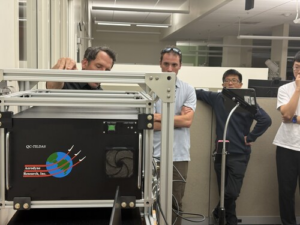
A groundbreaking discovery in material science could revolutionize the clean energy industry. Researchers have developed a man-made crystal capable of “breathing” oxygen, potentially transforming energy efficiency and aiding the transition to cleaner energy sources. This innovative material, composed of an oxide of strontium, iron, and cobalt, has demonstrated the ability to release and reabsorb oxygen, mimicking the function of human lungs. The crystal’s resilience allows it to perform this cycle repeatedly without degradation, opening up a wide array of applications in the clean energy sector.
The study, co-authored by Professor Hyoungjeen Jeen from Pusan National University in South Korea and Professor Hiromichi Ohta from Hokkaido University in Japan, was published in the journal Nature Communications. “It is like giving the crystal lungs and it can inhale and exhale oxygen on command,” Jeen explained. The crystal, with the chemical formula SrFe0.5Co0.5O2.5, offers a promising solution to longstanding challenges in material science.
Breaking New Ground in Material Science
Natural substances often bond with and release oxygen, a critical element for life on Earth. However, replicating these processes in a laboratory setting has proven difficult. Traditional methods often degrade materials quickly or require extreme temperatures, limiting their commercial viability. This new crystal, however, operates efficiently at moderate temperatures of approximately 752 °F (400 °C), maintaining its structure throughout the oxygen absorption and release cycle.
Professor Jeen highlighted the significance of this discovery, noting, “This finding is striking in two ways: only cobalt ions are reduced, and the process leads to the formation of an entirely new but stable crystal structure.” When oxygen is reintroduced, the original crystal structure is restored, showcasing the material’s robustness.
Potential Applications and Industry Impact
The unique properties of these crystals could be transformative for technologies like solid oxide fuel cells. These cells generate electricity from hydrogen with minimal emissions, and the ability to control oxygen at lower temperatures could extend the range of electric vehicles. Additionally, the crystals’ potential extends to thermal transistors and smart windows, which adjust heat flow based on weather conditions, significantly enhancing building energy efficiency.
According to Phys.org, “The ability to control oxygen also plays a role in thermal transistors—devices that can direct heat like electrical switches—and in smart windows that adjust their heat flow depending on the weather.” Given that buildings currently consume more energy than transportation and industry combined, the implications for climate goals are substantial.
Future Research and Development
The research team has already begun exploring the application of these crystals in smart windows. “They’ve found out that the material changes transparency based on its oxygen content, with the oxygen-rich version appearing less transparent while the oxygen-depleted version showing increased transparency,” reports Design Boom. This discovery could lead to further advancements in electronics, including oxygen sensors and gas separation systems.
Professor Ohta expressed optimism about the future, stating, “This is a major step towards the realization of smart materials that can adjust themselves in real time. The potential applications range from clean energy to electronics and even eco-friendly building materials.”
Looking ahead, the research team plans to refine the crystal’s composition and processing methods to enhance performance and durability. By experimenting with different metal ratios, they aim to improve upon the current formulation of SrFe0.5Co0.5O2.5.
This development represents a significant leap forward in material science, with the potential to impact various industries profoundly. As research continues, the possibilities for cleaner, more efficient energy solutions appear increasingly within reach.






